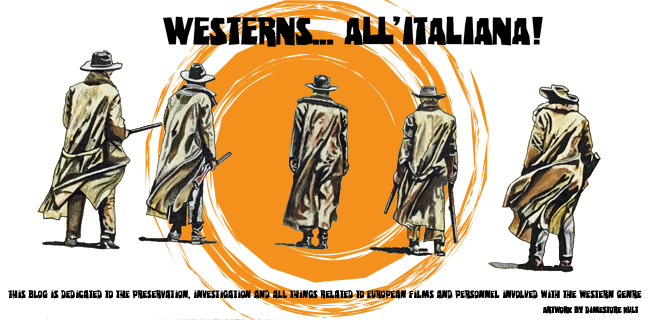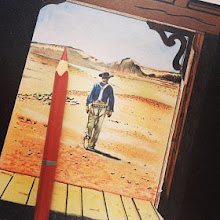By Brad Gullickson
November 16, 2017
Sergio Corbucci’s lost masterpiece finally gets its
proper presentation after years in a cult status limbo.
Film Movement has recently finished a new 2K HD
restoration of Sergio Corbucci’s painfully brutal Spaghetti Western, The Great
Silence, and plan on distributing it sometime next year. Through the good folks
at the Alamo Drafthouse in Winchester, Va I was lucky enough to attend their
Film Club 3.0 presentation of an ultra-early advanced screening. Often cited as
an inspiration to filmmakers like Quentin Tarantino and Alex Cox, The Great
Silence never got proper distribution in the United States because its blacker-than-midnight
ending offended 20th Century Fox studio head, Darryl Zanuck, so deeply. Plans
to remake the film with Clint Eastwood eventually fell through. Zanuck locked
the film in their vault and The Great Silence was just that until a small DVD run
occurred in 2001. While Sergio Leone has enjoyed decades of acclaim for his
slightly bent take on the classic American movie genre, Corbucci has earned a
rabid cult status from fans looking to have their oaters dragged a little
deeper through the mud.
In The Great Silence, hero and villain dawn the black
hat. The Italians had no interest in Hopalong heroism, their Westerns
flourished in an era plagued with cynicism and downright contempt for
government. They do not allow their audience an escape from their terrible
realities. Our hero is a savage gunslinger who had his voice literally cut from
his throat when he was just a child. He’s not the first choice to take up the
good cause for the people of Snow Hill, but when the newly established Sheriff
reveals himself to be just another shill, a killer for hire is better than a
life of continual starvation.
Inspired by action after the assassinations of Malcolm X
and Che Guevara, Sergio Corbucci rekindled his enthusiasm in the Western by
attacking his audience for their culpability in this perceived injustice. If we
were unable to enact positive change on this planet then we do not deserve the
righteous, heroic ending. Of course, we don’t really go to Spaghetti Westerns
for their moral code. The Man With No Name was not afraid to draw first, but he
was often given the last word, and he always walked away healthy if not
entirely unburdened. The other Sergio (Leone) was a master craftsman who wowed
audiences with his execution as much as the bravado of his characters. Corbucci
had no desire for slick, meticulously choreographed duels. The action of The
Great Silence is messy, often muddled, and often results in an unjustifiable
homicide. This is a movie about bastards for bastards.
Having supposedly already claimed revenge on the monsters
that sacked his homestead and slaughtered his family, Silence (Jean-Louis
Trintignant) roams the west seeking to right wrongs through further acts of
vengeance. If he could speak would he have a single pleasantry to offer? No.
He’s a specter we should fear as much as the next hard case that storms into
town on horseback. However, the right grieving mother might ignite his
sympathies and his gun could be purchased for your justice. That will have to
do.
Klaus Kinski is a demon. His Loco is a walking, talking
nightmare draped in a woman’s shawl clamped to his noggin with a too-big
Captain Call cowboy hat. Each line of dialogue skips from his lips with a smile
but lands on his opponents with the sting of a bullet. Collecting bounties on
those Wanted Dead or Alive, Kinski’s lawfully sanctioned killer prefers the
former to the later. We should all sink a little further into our seats when he
steps into frame, but his psychotic chemistry is infectious, and The Great
Silence is at its most lively when he’s torturing the decent people of Snow
Hill.
There is a little space carved out for romance, but it’s
as foolish a dream as any other hope in the film. As a widow to one of the many
fallen, Vonetta McGee manipulates her grief to woo the terror of Silence. She
does not have much to offer him other than her bed and her sorrow. Somewhere
along her machinations, she may develop an actual infatuation, or they simply
just discover comfort in each other’s misery. However slim the believability of
this relationship, they fulfill the genre necessity for a little kissing before
the blaze of glory.
I’ve spent a lifetime enjoying Westerns that burn under
the hot sun and leave their characters baked in the desert. That’s the
environment we expect and crave from the genre. To experience this oddity that
truly punishes its characters for foolishly planting themselves in the
mountains of Utah (filmed on location in the Italian Dolomites) is at first
off-putting. Corbucci rarely gives his characters a proper portrait. They are
often shadowed in dim cabins or blanketed in a blinding whiteout. On several
occasions, I found myself squinting to simply see which actor was being
murdered now. This is not a sweeping epic. It’s a claustrophobic horror filled
with anger at your audacity to purchase a movie ticket.
The Great Silence has no interest in offering us a happy
ending. We simply don’t deserve to ride off into the sunset. We don’t even
deserve a living damnation. We only deserve death, and that’s what we get.
Sergio Corbucci leaves us hollow, our insides scooped out and splayed across
the silver screen. For our sins on this planet, The Man With No Name does not
get the final word. He does not get the cool comeback or the slick quickdraw.
He only gets the honesty of a bullet, and we get to share that reality with
him.












